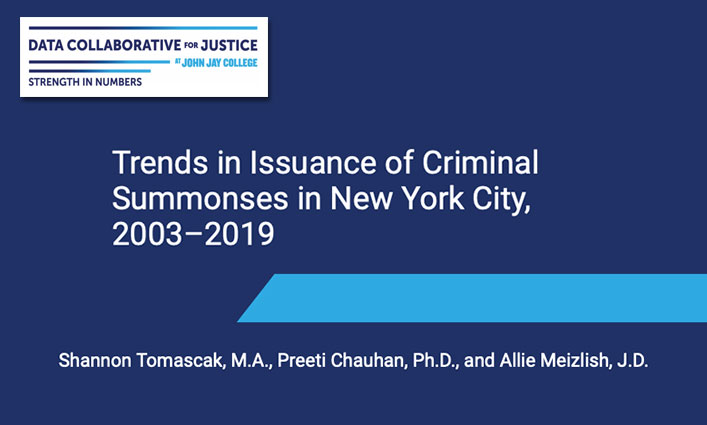
CJRA Reform Leads to Steep Declines; 18-24 Year Olds And Black Most Cited in 2019; Marijuana Replaces Alcohol as Most Frequent Charge
December 17, 2020—In 2019, young people, Black people, and people in the Bronx were most likely to be issued criminal summonses in New York City despite a significant decline in the number issued since the Criminal Justice Reform Act (CJRA) was implemented in June 2017, according to a new report, Trends in Issuance of Criminal Summonses in New York City, 2003-2019, from the Data Collaborative for Justice (DCJ) at John Jay College.
“Our research shows criminal summons issuance has been declining for years and these declines accelerated after the City Council passed the Criminal Justice Reform Act – resulting in hundreds of thousands fewer criminal cases for things like littering and drinking in public,” said Preeti Chauhan, Director of the Data Collaborative for Justice and Psychology Professor at John Jay College. “However, challenges remain — communities of color continue to be disproportionately impacted by summons issuance and there are still 700,000 open warrants associated with criminal summonses.”
A criminal summons is an appearance ticket, mostly issued by the police, for committing certain lower-level offenses such as disorderly conduct, marijuana possession, and violations of transit authority rules, including turnstile jumping.
The CJRA encouraged the use of civil rather than criminal summonses for certain offenses, allowing police officers to issue a civil summons rather than a criminal summons for five offenses: (1) public consumption of alcohol, (2) public urination, (3) littering, (4) unreasonable noise, and (5) NYC Park Rules offenses.
By moving enforcement of many of these offenses out of the criminal courts, the City Council and the Mayor sought to create more proportionate responses to these lower-level, non-violent offenses. They also sought to reduce the number of warrants issued for New Yorkers who failed to appear for a criminal summons, thereby reducing collateral consequences.
Highlights of the DCJ findings:
- Criminal summons issuance has declined dramatically: From 541,862 summonses in 2003 to 72,314 in 2019, an 87% decline.
- Much of the decline in criminal summons issuance is likely the result of the Criminal Justice Reform Act: In the 2.5 years after implementation of the Criminal Justice Reform Act (CJRA), criminal summons issuance declined by 71% compared to the prior 2.5 years (from 757,669 criminal summonses issued to 214,258). (See p. 3 of the report, “Policy Changes Impacting Criminal Summonses,” for additional details).
- Marijuana possession criminal summonses increased over time and marijuana possession was the most frequent charge in 2019: Although public consumption of alcohol was the most frequently issued criminal summons over the 17-year study period, it declined by 96% during this time (from 106,500 summonses in 2003 to 3,878 in 2019) and was replaced by marijuana possession as the most frequently issued criminal summons in 2019. The increase in marijuana possession summonses was likely a result of a series of reforms aimed at reducing the number of custodial arrests for marijuana (See p. 3 of the report, “Policy Changes Impacting Criminal Summonses,” for additional details).
- In 2019, young people were most likely to be issued a criminal summons: The three youngest age groups (16-17, 18-20, 21-24) received a larger number of criminal summons than any other age group, most frequently for disorderly conduct and marijuana possession.
- In 2019, Black people accounted for the largest proportion of the most commonly issued summonses: Marijuana possession (45.5%), violations of transit authority rules such as turnstile jumping (42.6%), disorderly conduct (42.0%), and public consumption of alcohol (41.2%).
- Warrants associated with people not showing up to court for their criminal summons declined dramatically over time but almost 700,000 warrants remain open, and in 2019, warrants were most frequently issued in cases involving marijuana possession: From 2003 to 2019, a total of 2,622,168 warrants were issued (in 37% of summons). The number of warrants issued each year decreased by 88%, from 192,117 warrants issued in 2003 to 23,454 warrants issued in 2019. In 2019, the greatest number (4,229) and proportion (18%) of warrants issued were for marijuana possession. Currently, almost 700,000 of the warrants accumulated between 2003 and 2019 remain open.
- Between 2003 and 2019, the Bronx and Manhattan had the highest rates of summons issuance and in 2019, two precincts in the Bronx, the 44th and 40th precincts, issued the largest number of criminal summonses: These two precincts accounted for 11% of all criminal summonses issued in 2019. A significant proportion of the most commonly enforced summons were issued in the Bronx -- public consumption of alcohol (39.8%), violations of transit authority rules (39.7%), disorderly conduct (36.1%), and marijuana possession (33.5%).
“The statistics from the Data Collaborative for Justice show that it’s possible to keep thousands out of the criminal legal system while still maintaining safe communities,” said John Jay College of Criminal Justice President Karol V. Mason. “But more needs to be done to address the disparities shown in the report. Far too many young, Black and brown people are still being unnecessarily caught up in the criminal justice system.
“Since the Council passed the Criminal Justice Reform Act in May of 2016, the reduction in criminal summonses enforcement for minor, non-violent offenses is just and fair, and has spared thousands of New Yorkers of having unnecessary criminal records that can hurt them throughout their lives. Because of the Council’s legislation, many low-level, non-violent offenses are settled with civil fines, not in criminal court. Although criminal summonses dropped drastically, racial disparities continue, and we have to keep working to eliminate these disparities," said Council Speaker Corey Johnson.
"The highly valuable research done by the team at John Jay College's Data Collaborative for Justice shows the significant impact the Criminal Justice Reform Act has had in reducing the over criminalization of low-level offenses," said Brenda Velazquez, Executive Director of Research Operations at the Mayor’s Office of Criminal Justice. "The research also shows that there remain disparities in the system that need to be addressed."
“The fact that crime continued to decline in New York City even as we implemented historic reforms aimed at reducing the over enforcement of criminal summonses for low-level, quality-of-life crimes is evidence that our criminal legal system can operate both safely and fairly,” said Council Member Keith Powers, Chair of the Committee on Criminal Justice.
“This research shows the tremendous impact the Criminal Justice Reform Act (CJRA) had on New Yorkers, but African-Americans and youth are still disproportionately receiving criminal summonses in our city,” said Council Member Vanessa L. Gibson, Co-Chair of the NYC Council Women’s Caucus. “Even as progress has been made, the data is further proof that we still have a long way to go before achieving legal equity and fairness in our criminal justice system.”
The full report is available here: Trends in Issuance of Criminal Summonses in New York City, 2003-2019
About The Data Collaborative for Justice:
The Data Collaborative for Justice (DCJ) at John Jay College of Criminal Justice houses a group of research initiatives that raise important questions and share critical research about the criminal legal system and its role in creating safe, just, and equitable communities. DCJ conducts data analysis and research on enforcement in the community, the adjudication of cases in the courts, and the use of confinement in jails and prisons. DCJ’s work has informed policy reforms, facilitated partnerships between researchers and government agencies across the country, spurred new scholarly research on lower-level enforcement, and has been cited extensively in the press. For more information about the Data Collaborative for Justice please visit: https://datacollaborativeforjustice.org/
About John Jay College of Criminal Justice:
An international leader in educating for justice, John Jay College of Criminal Justice of the City University of New York is a Hispanic-Serving Institution and Minority-Serving Institution offering a rich liberal arts and professional studies curriculum to 15,000 undergraduate and graduate students from more than 135 nations. John Jay is home to faculty and research centers at the forefront of advancing criminal and social justice reform. In teaching, scholarship and research, the College engages the theme of justice and explores fundamental human desires for fairness, equality and the rule of law. For more information, visit www.jjay.cuny.edu and follow us on Twitter @JohnJayCollege.



